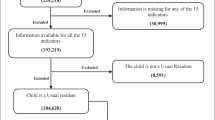Abstract
Child poverty, as a critical indicator of the QOL, is intricately related to the social structure of the community. This hypothesis is explored for the 159 counties of Georgia for the year 2000. The influence of demographic, economic, family and health factors upon child poverty are explored through models of total, black and white child poverty. Factor analyses of factors uncovered by the models identify the social-structural features of counties in relation to child poverty. Counties considered “Deprived/rural” harbor child poverty, while counties described as “Business/money” and “Progressive/urban” bear a negative relationship to child poverty. Positively associated with child poverty are residential stability, unemployment, low educational achievement, youth and age dependency, single-parent female household heads with children, grandparent child care, and health disability of child, elders and of working-age persons. Structural factors militating against child poverty are persons with greater education, higher population density, out migration, larger married population, higher retail sales, larger middle class families, higher weekly wages, and other structural features of the county.
Similar content being viewed by others
References
Bachtel D.C. (2002). The Georgia County Guide. Cooperative Extensive Service, Athens, GA
Blau P. (1977). Inequality and Heterogeneity. Academic Press, New York
Caplow, T., H.M. Bahr, J. Modell and B.A. Chadwick: 1991, Recent Social Trends in the United States, 1960–1990 (McGill-Queens University Press, Montreal & Kingston)
Carter B. (2002). ‘People power: Harre and the myth of social structure’. European Journal of Social Theory 5/1: 34–142
Coleman J.S. (1990). The Foundations of Social Theory. Harvard University Press, Cambridge, MA
Harre R. (2002). ‘Social reality and the myth of social structure’. European Journal of Social Theory 5/1: 111–123
Hernandez D.J. (1993). America’s Children: Resources from Family Government and the Economy. Russell Sage Foundation, New York
Johnson A.G. (2000). The Blackwell Dictionary of Sociology. Blackwell Publishers, Inc, Malden, MA
Leach E.R (1958). ‘Social Structure: The History of the Concept’. In: Sills, D.L. (eds) International Encyclopedia of the Social Sciences, Vol 14 The Macmillan Company and the Free Press, NY pp 482–489.
Merton R. (1968). Social Theory and Social Structure. The Free Press, NY
Rytina S.L. (2000). ‘Social Structure’. In: Borgotta, E.F. and Montgomer , R.J.V. (eds) Encyclopedia of Sociology, Vol 4 Macmillan Reference, NY USA pp 2822–2828.
Skees J.R. and Swanson L.E. (1988). Farm Structure and Local Society Well-Being in the South’. In: Beaulieu, L.J. (eds) The Rural South in ‘Crisis: Challenges for the Future, Westview Press, Bolder and London pp 141–157.
Sltrydom P. (2002). ‘Is the social structure concept of structure a myth?’. European Journal of Social Theory 5/1: 124–133
Turk H. (1992). ‘Social Organization’. In: Borgatta, E.F. and Borgatta , M.L. (eds) Encyclopedia of Sociology, 4 Macmillan Publishing Company, New York pp 1970–1974.
Udy, S., Jr. (1968). ‘Social Structure: Social Structural Analysis’. In: Sills, D.L. (eds) International Encyclopedia of the Social Sciences, 14 The Macmillan Company and the Free Press, NY pp 489–495.
US Bureau of the Census.: 2000, ‘Weighted Average Poverty Thresholds’, Current Population Survey, Annual Demographic Survey of Poverty and Health Statistics Branch, HES Division, Washington: The Bureau
Author information
Authors and Affiliations
Corresponding author
Rights and permissions
About this article
Cite this article
Ferriss, A.L. Social Structure and Child Poverty. Soc Indic Res 78, 453–472 (2006). https://doi.org/10.1007/s11205-005-1606-7
Accepted:
Published:
Issue Date:
DOI: https://doi.org/10.1007/s11205-005-1606-7




